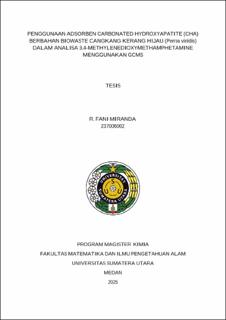Penggunaan Adsorben Carbonated Hydroxypatite (CHA) Berbahan Biowaste Cangkang Kerang Hijau (Perna viridis) dalam Analisa 3,4-Methylenedioxymethamphetamine menggunakan GCMS
The Utilization of Carbonated Hydroxiapatite (CHA) Adsorbent Derived from Green Mussel (Perna viridis) shell Biowaste in the Analysis of 3,4-Methylenedioxymethamphetamine using GCMS

Date
2025Author
Miranda, R Fani
Advisor(s)
Taufik, Muhammad
Andriayani
Metadata
Show full item recordAbstract
Green mussels produce shell waste that negatively impacts the environment. Green mussel shells contain 99.5% calcium. According to data from the North Sumatra Regional Police (Polda Sumut) up to July 2024, there were 2,400 narcotics cases uncovered, with evidence including 478.92 kg of methamphetamine, 484.29 kg of marijuana, and 178,691 ecstasy pills. Narcotics analysts require accurate methods with optimal extraction processes.The aim of this research is to analyze 3,4-methylenedioxymethamphetamine (MDMA) using Carbonated Hydroxyapatite (CHA) adsorbent derived from green mussel shell biowaste, in order to obtain more accurate MDMA analysis results. CHA was synthesized using the wet precipitation method by allowing the mixture to settle for 24 hours and then calcining it at 1000°C. SEM–EDX results showed that the surface morphology appeared heterogeneous with a rough and porous texture. XRD analysis was used to identify the crystal structure and crystallinity level of CHA, showing a crystallite size at the 2θ peak around 32° of approximately 83 nanometers. FTIR analysis indicated carbonate (CO₃²⁻) substitution at wave numbers 1450 cm⁻¹ (ν₃ CO₃²⁻) and 870 cm⁻¹ (ν₂ CO₃²⁻). The synthesized CHA was used as an adsorbent for MDMA in urine samples from drug users. Qualitative analysis using the Chemical Spot Test showed a dark purple color, and Thin Layer Chromatography (TLC) gave an Rf value of 0.555. The highest MDMA adsorption percentage occurred at a contact time of 30 minutes for each concentration. Method validation was performed, and the obtained values for accuracy, precision, linearity, LOD, LOQ, and selectivity were 99.32%, 0.0873%, 0.9971, 0.0000023 ppm,
0.0000075 ppm, and 19.83, respectively
Collections
- Master Theses [381]
